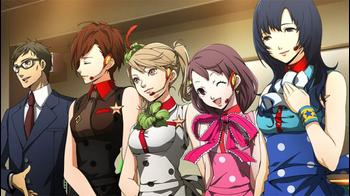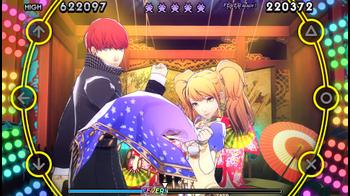Persona 4: Dancing All Night Review
When Persona 4: Dancing All Night was first announced, it was met with almost universal skepticism. How do you take a role-playing experience and blend it with a music rhythm game with your favorite characters grooving to club music? While wearing an assortment of costumes and accessories? Turns out, it goes together naturally.
In the original Persona 4, the story explored the concept of breaking down the barriers of one’s facade and learning to accept that we are all different. While we may have things we aren’t proud and certain imperfections we would rather keep buried, there is only one of us in the world and it is important to accept those unique qualities.
In Persona 4: Dancing All Night, many of those topics are breached in a moderately different fashion. Rise Kujikawa vows to make a return to the top of the idol industry. In order to that she calls upon Chie, Yukiko, Yosuke, Kanji, Teddie, and Yu to perform as her back-up dancers at an upcoming music festival.
Standing in her way of stardom is Kanamin Kitchen, the hottest idol group on the scene. They are led by Kanami Mashita, an earnest girl who is friends/rivals with Rise.
After an urban legend spreads related to a terrible fate that can happen from watching a cursed video online, most of the idol group goes missing. It is up to Yu and the rest of the group to rescue them back to safety.
But, in a bad case of déjà vu, they are transported through a weird portal and find themselves on in a dimension called the Midnight Stage surrounded by the same shadows they fought in the original game.
They soon learn they can’t use their Personas to fight, but instead must use the power of dance to save their captured friends.
Let’s just say you shouldn’t take this plot too seriously. The story told in a visual novel format is over soon after it begins, but the time I spent with it I had a good time with the at-times absurd antics of the Investigation Team and the light-hearted atmosphere.
It felt like filler for a game that could have instead provided more content elsewhere, but the story mode is harmless and well put-together.
What you should be excited about is the gameplay itself. Star notes travel from the center of the screen to the peripheral where button icons have you tapping Triangle, Circle, or Cross on the right side, and Up, Left, and Down on the left side.
Blue rings can also appear and travel outwards, and all it takes is a simple flick of either analog stick to trigger. These optional notes have no negative effect on your combo, but can be used to build it. Rainbow-colored “fever” rings can also appear, and by triggering three of them, this can activate a “Fever Mode” that allows a partner character to join you on stage.
Anyone with a sense of rhythm will quickly become comfortable with this set up as it takes very little explaining to understand. Even someone like me who doesn’t play a lot of these games outside of the Project Diva series could settle right in with no trouble.
Those looking for more of a challenge will be able to purchase different items at the in-game shop that can have a profound effect on the speed and complexity of the notes. There are also four different difficulty modes, one which needs to be unlocked, which gives the game a lot of its replayability.
Each performance is wonderfully choreographed. Getting caught up with what is happening on stage can be distracting when you are trying to pay attention to the moving notes, but that is where a lot of the appeal originates.
It’s amazing to see how much of a character’s personality is emphasized in how they dance, whether it’s Yukiko’s beautiful ballet moves to Kanji’s moshing, it’s all highly entertaining.
The downside is that each character is locked to their specific song, so you won’t be able to choose Naoto for every performance (heartbreaking, I know).
It’s an example of one thing Atlus could have done instead of pouring effort into the story mode, but I got used to this limitation.
I will point out I had the same difficulty keeping up with the songs I did in the Hatsune Miku games. Trying to play on some of the lower difficulties can excruciate when you expect a note to be there and it's not.
It is difficult to figure out what sort of rhythm I was supposed to have with my button presses, so my timing rarely matched the pace of the song. Thankfully, the higher difficulties exist for a reason, and the tracks that relied more on an energetic or dubstep sound made up for the more uneven tunes in the library.
While there are about 26 different songs to choose from (more coming as DLC), many of the songs are recycled to where you’ll see two or three versions of the same tune. That’s not a knock against the game though since the remixes are so brilliant that each track can be uniquely identified.
Daisuke Asakura, Lotus Juice and the legendary Akira Yamaoka are just a few of the artists that contribute to the soundtrack. It's thanks in part to them I fell in love so hard with almost every song I heard.
Tracks like Chie’s “Best Friends (Banvox Remix)” and Yukiko’s “Snowflakes (Narasaki Remix)” are especially memorable. The mix of the music and the amazing choreography sold me on the entire experience.
While it will be up to the player to decide how much the overall appeal will last, I had a great time with Persona 4: Dancing All Night. Those who have played the original game will enjoy seeing their old friends again, and I am sure they will fall in love with the soundtrack just as I have.
It may not have the depth that some will desire, but after spending dozens of hours in the Free Dance mode alone, I had a great time. The presentation is what this game capitalizes on, which should be enough for players to take notice. For the fans, this comes highly recommended.

